
Conjoined twins, popularly referred to as Siamese twins, are twins joined in utero. It is a very rare phenomenon, estimated to occur in anywhere between one in 49,000 births to one in 189,000 births, with a somewhat higher incidence in Southwest Asia and Africa. Approximately half are stillborn, and an additional one-third die within 24 hours. Most live births are female, with a ratio of 3:1.
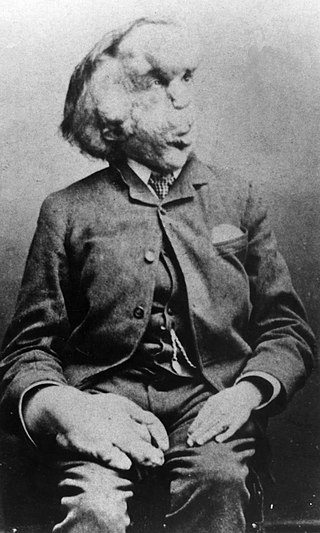
Joseph Carey Merrick, often erroneously called John Merrick, was an English man known for his severe physical deformities. He was first exhibited at a freak show under the stage name "the Elephant Man", and then went to live at the London Hospital, in Whitechapel, after meeting Sir Frederick Treves, subsequently becoming well known in London society.

A birth defect, also known as a congenital disorder, is an abnormal condition that is present at birth regardless of its cause. Birth defects may result in disabilities that may be physical, intellectual, or developmental. The disabilities can range from mild to severe. Birth defects are divided into two main types: structural disorders in which problems are seen with the shape of a body part and functional disorders in which problems exist with how a body part works. Functional disorders include metabolic and degenerative disorders. Some birth defects include both structural and functional disorders.

Leah appears in the Hebrew Bible as one of the two wives of the Biblical patriarch Jacob. Leah was Jacob's first wife, and the older sister of his second wife Rachel. She is the mother of Jacob's first son Reuben. She has three more sons, namely Simeon, Levi and Judah, but does not bear another son until Rachel offers her a night with Jacob in exchange for some mandrake root. Leah gives birth to two more sons after this, Issachar and Zebulun, and to Jacob's only daughter, Dinah.

Mary and Eliza Chulkhurst, commonly known as the Biddenden Maids (1100–1134), were a pair of conjoined twins supposedly born in Biddenden, Kent, England, in the year 1100. They are said to have been joined at both the shoulder and the hip, and to have lived for 34 years. It is claimed that on their death they bequeathed five plots of land to the village, known as the Bread and Cheese Lands. The income from these lands was used to pay for an annual dole of food and drink to the poor every Easter. Since at least 1775, the dole has included Biddenden cakes, hard biscuits imprinted with an image of two conjoined women.

Craniopagus parasiticus is an extremely rare type of parasitic twinning occurring in about 2 to 3 of 5,000,000 births. In craniopagus parasiticus, a parasitic twin head with an undeveloped body is attached to the head of a developed twin. Fewer than a dozen cases of this type of conjoined twin have been documented in literature.

Josephine Myrtle Corbin was an American sideshow performer born as a dipygus. This referred to the fact that she had two separate pelvises side by side from the waist down, as a result of her body axis splitting as it developed. Each of her smaller inner legs was paired with one of her outer legs. She was said to be able to move her inner legs, but they were too weak for walking.

Joseph Edward Murray was an American plastic surgeon who performed the first successful human kidney transplant on identical twins Richard and Ronald Herrick on December 23, 1954.
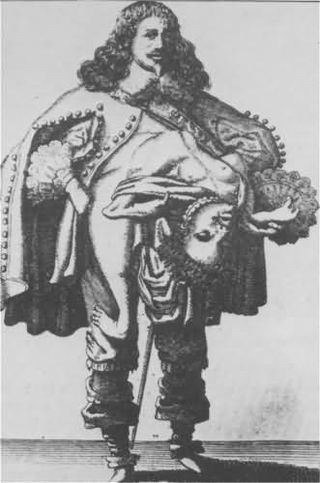
Lazarus Colloredo and Joannes Baptista Colloredo were Italian conjoined twins who toured freak shows in 17th-century Europe. They were born in Genoa, Italy.
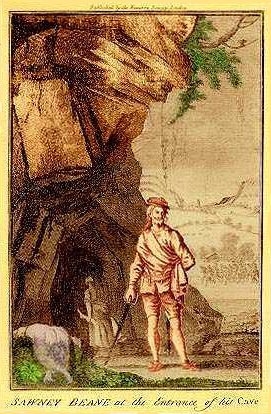
Alexander "Sawney" Bean is a legendary figure, said to be have been the head of a 45-member clan in Scotland in the 16th century that murdered and cannibalised over 1,000 people in 25 years. According to the legend, Bean and his clan members were eventually caught by a search party sent by King James VI and executed for their heinous crimes.

Cabinets of curiosities, also known as wonder-rooms, were encyclopedic collections of objects whose categorical boundaries were, in Renaissance Europe, yet to be defined. Although more rudimentary collections had preceded them, the classic cabinets of curiosities emerged in the sixteenth century. The term cabinet originally described a room rather than a piece of furniture. Modern terminology would categorize the objects included as belonging to natural history, geology, ethnography, archaeology, religious or historical relics, works of art, and antiquities. In addition to the most famous and best documented cabinets of rulers and aristocrats, members of the merchant class and early practitioners of science in Europe formed collections that were precursors to museums.

Klippel–Feil syndrome (KFS), also known as cervical vertebral fusion syndrome, is a rare congenital condition characterized by the abnormal fusion of any two of the seven bones in the neck. It can result in a limited ability to move the neck and shortness of the neck, resulting in the appearance of a low hairline. Most people only have one or two of those symptoms so it may not be noticeable without medical imaging.

Polycephaly is the condition of having more than one head. The term is derived from the Greek stems poly meaning "many" and kephalē meaning "head". A polycephalic organism may be thought of as one being with a supernumerary body part, or as two or more beings with a shared body.

Diprosopus, also known as craniofacial duplication, is an extremely rare congenital disorder whereby parts (accessories) or all of the face are duplicated on the head.

Futakuchi-onna is a type of yōkai or Japanese monster. She is characterized by her two mouths – a normal one located on her face and a second one on the back of the head beneath the hair. There, the woman's skull splits apart, forming lips, teeth and a tongue, creating an entirely functional second mouth.
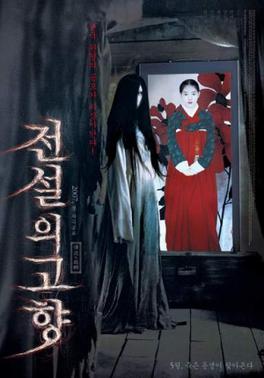
Evil Twin is a 2007 South Korean horror film. When an accident claims the life of a young girl, during the same incident her twin sister fell into a coma and awakens 10 years later. Many deaths follows her recovery, and she seemingly takes on her sister's personality traits.
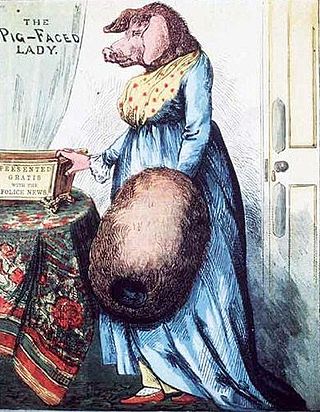
Legends featuring pig-faced women originated roughly simultaneously in The Netherlands, England and France in the late 1630s. The stories tell of a wealthy woman whose body is of normal human appearance, but whose face is that of a pig.
"Edward Mordrake" is a two-part episode, consisting of the third and fourth episodes of the fourth season of the anthology television series American Horror Story. The first part aired on October 22, 2014, and the second on October 29, 2014, on the cable network FX. The first part was written by James Wong and directed by Michael Uppendahl and the second part was written by Jennifer Salt and directed by Howard Deutch.
Craniopagus twins are conjoined twins who are fused at the cranium. The union may occur on any portion of the cranium, but does not primarily involve either the face or the foramen magnum; their brains are usually separate, but they may share some brain tissue. Conjoined twins are genetically identical and always share the same sex. The thorax and abdomen are separate and each twin has their own umbilicus and umbilical cord.
Patrick Wensley Clarkson,, was a plastic surgeon at Guy's Hospital in London, best known for surgery of the hand and the description of "Poland Syndactyly", later termed Poland syndrome.

















